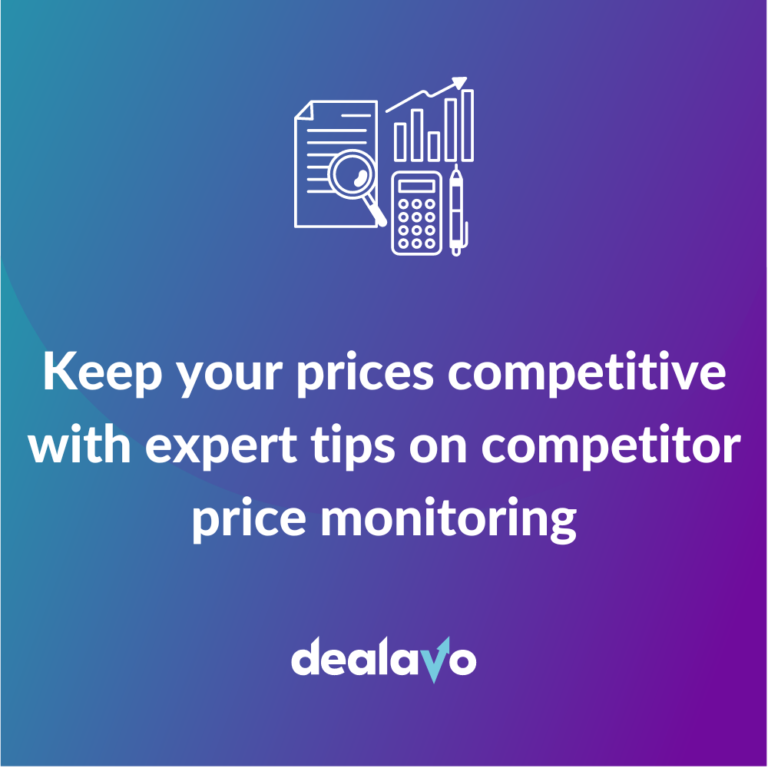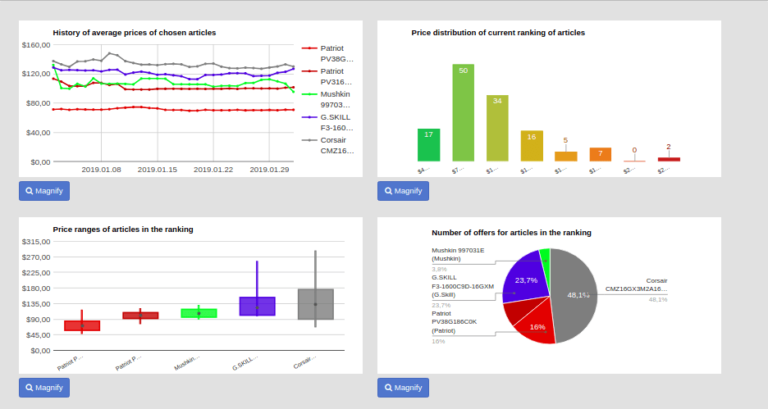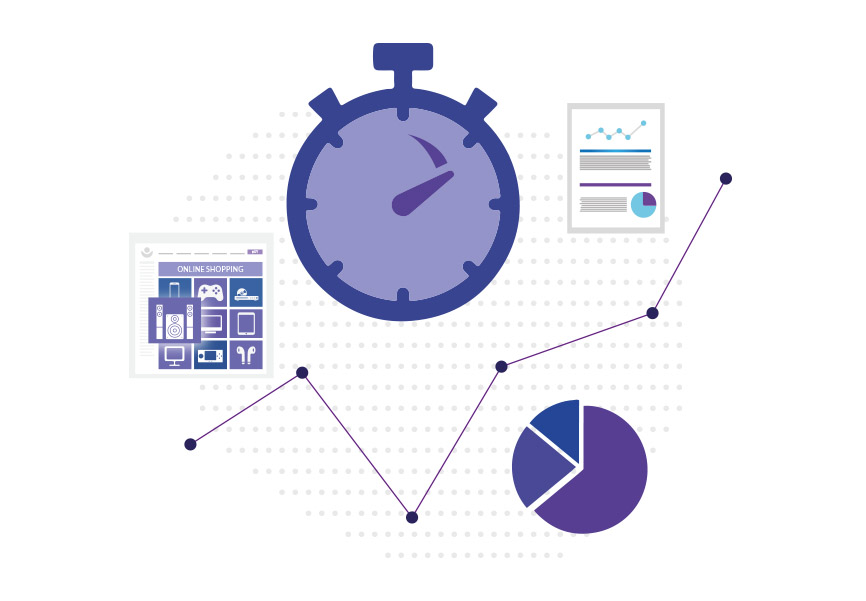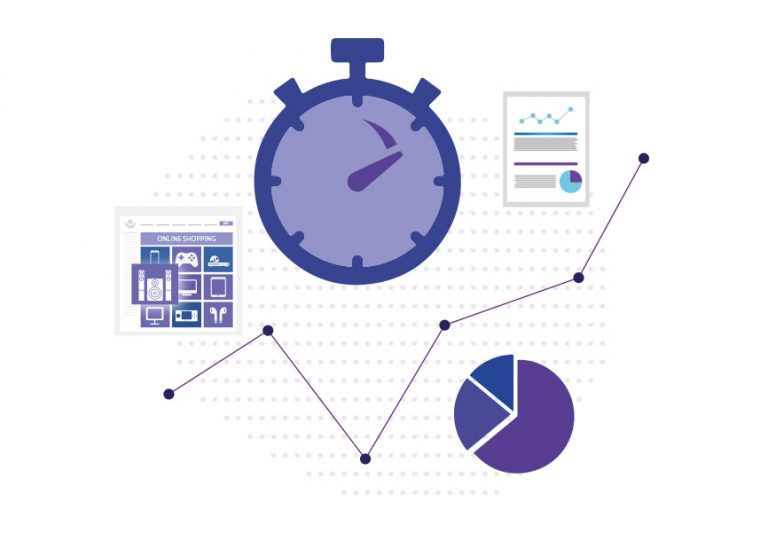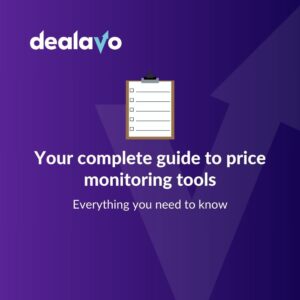
Your complete guide to Price Monitoring
- 05 September 2024
Managing an e-commerce business can be challenging, and as the e-shop grows, so does the number of tasks that need to be performed. Administration, product procurement (or manufacturing), pricing and delivery, customer support, advertising, warehousing – these are just some of the tasks that require attention. Between all that, you have to find the time to monitor your competition to stay ahead. Fortunately, there is software on the market that help with this task. Today, we focus on e-commerce price monitoring tools, highlighting their benefits to online shop managers.
What is price monitoring?
By monitoring product prices you collect data on your competition allowing you to decide the best course of action for your company’s pricing policy, which results in maximising the effectiveness of your sales. Shops that are not flexible in this area often lose the race with their competition. The key to success is to manage prices in such a way to attract customers while still fulfilling your business goals. Manual price monitoring is usually a tedious task, which is why more and more companies turn towards automation.
Key benefits of price monitoring
You gain a lot if you pay attention to how other companies manage pricing for the same products. Here are a few advantages of competitor price monitoring:
- Competitive pricing – if you know what others are doing, you can react quickly and provide customers with a better offer. Sometimes, a price drop of just a few % will give you an edge over your competition and increase your sales without sacrificing much.
- Market insights – identify markets of opportunity. Perhaps you are able to sell your product in a new market at a lower price, or maybe there’s a place where the competition is weak or nonexistent.
- Customer satisfaction – price monitoring will make it easier for you to understand your customers and their expectations, allowing you to provide better offers and special deals at the right time.
- Profit maximisation – when you know product prices, you know your limits. You are able to identify the best offer you can give based on your capabilities, the competition and market conditions, making sure you maximise your profits at any given time.
The importance of price monitoring
If there is competition in your industry, you can be certain many of the companies monitor product prices of others operating in their field, gaining an edge over those whose pricing policies do not adapt to changing market conditions. As mentioned earlier, in some cases it is enough to reduce the price by just a few percent to overtake most if not all of your competitors, while in other situations, you might bump up your price while still remaining on top because other companies’ offers are still too expensive to meet customer expectations.

Types of price monitoring
There are two ways companies can perform price monitoring – either manually, with software used to input the collected data, or automatically with specialised suites powered by AI that do most of the work.
Manual price monitoring – pros, cons and tools
Performing the activities manually may cost less than subscribing to a provider’s price monitoring app, and it may make sense if you only wish to monitor a few products with limited competition, but this is where the major advantages end. As for disadvantages of manual price monitoring:
- It is far more time consuming and tedious than automated solutions since algorithms analyse product listings much more quickly.
- It requires a lot of focus from your employees, blocking them from performing other tasks.
- Human errors are much more likely to occur during manual monitoring.
- Since manual price tracking is more time consuming, the updates cannot be performed so frequently, making the information obsolete more quickly.
- Automated solutions sometimes provide inbox notifications about price changes, so it is possible to get updates even when not actively using the software.
As for the software used in manual price monitoring, for many people a simple MS Excel spreadsheet will be enough. If this is the method you are interested in, you might want to check out our article on useful Excel templates prepared for this particular task.
Automated price monitoring – pros, cons and tools
There is a lot to gain if you decide to use specialised tools, and the only downside is that usually a monthly subscription to a provider is required. Here are some of the advantages of automated price monitoring:
- It’s much faster than manual price monitoring.
- In some cases there is no limit to the number of products and marketplaces you would like to monitor.
- It requires far less time, which means your employees can work on other tasks.
- Some software allows you to use filters and presets to quickly view specific information on products and shops.
- It may be possible to receive notifications about price changes to your email address.
- Some brands allow you to monitor stock levels of online shops through the software.
- It may be possible to monitor product prices along with shipping costs.
- There are brands that provide historical tracking so you can see how product prices change over time.
- Complete price management suites also provide automated repricing, so you can set up specific conditions determining how your product prices are to change in response to competitor activities. More on that topic later in the dynamic pricing section.
There are numerous price monitoring software available on the market:
- Dealavo – a complete suite for price monitoring and repricing, with a number of interesting functionalities, including advanced filtering, price monitoring combined with delivery costs, automated repricing, customisable email notifications and more.
- Repricer.com – a tool that monitors competitor product pricing with relevance to your own offers and establishes a course of action – raising or lowering your product prices depending on a variety of conditions.
- Competera – leveraging the power of AI, this tool helps brands set optimal prices for their products across multiple sales channels
- Minderest – a set of tools used to monitor product range and prices related to specific retailers, marketplaces and price comparison sites, supporting multiple languages, countries and currencies.
- Price2Spy – an online tool designed for price monitoring, repricing and price analytics, with custom email notifications.
- Prisync – with a single dashboard you are able to monitor and track competitor prices and stock info, making sure you are always one step ahead.
- Skuuudle – a service for price comparison, targeting millions of products and as many competitors as needed.
- Wiser Solutions – a solution that analyses online and in-store information, enabling businesses to act on these insights and drive growth.
- Intelligence Node – a pricing data suite powered by AI algorithms helping with product price optimisation.
We have prepared an article on the 10 best price monitoring tools for ecommerce you might want to read next.
Dynamic pricing
This is a type of pricing strategy where the price of a product fluctuates depending on the rules of a specific market. Online shops often use software to automate the process. The general pattern of automatic/dynamic pricing is usually as follows:
- Select the product or products you would like to set the rules for.
- Select the sources that you would like to monitor (marketplaces, online shops).
- Determine the rules for price changes by selecting the available options (e.g., if the selected product is 5% cheaper, lower the price of my product by 5.5%)
- Review and confirm your rules.
Some software types can automatically recommend price changes and just ask for your final confirmation every time your product price is to be modified. Dynamic pricing is very useful and time saving, especially for businesses that have many products on offer so manual price management would prove ineffective. Its most important advantage is that you are able to quickly react to price changes on the market, so you can quickly adapt your strategy and outmatch the competition.

How price monitoring works
In the next few lines we delve a bit deeper into the mechanisms of online price monitoring. We break it down to a number of smaller subjects, each requiring a separate introduction.
Data collection
The process is all about acquiring relevant and up to date information about relevant products, and using it to gain an edge over competitors.
Manual and automated data scraping
The information on products can be collected manually, but the work can be tedious and time-consuming, which is why most companies today use software to perform the task automatically. It is only logical when you think about how rich the list of products can be on platforms such as eBay or Amazon, but smaller online ecommerce businesses can also have thousands of items on sale.
Frequency of data updates
Manual data scraping may be problematic due to the fact that prices can change. There is only so much information a human can collect and process before it becomes obsolete, and with large chunks of data, it is impossible to perform updates frequently. Fortunately, there are no such constraints for specialised software – or rather – the frequency of the updates will usually depend on the company’s budget and the subscription plan that was purchased. The exact number of updates is different between different providers, but the options usually range from a few times a month to a few times a week.
Data analysis
The information can be analysed and interpreted in a number of ways, depending on what our business currently needs.
Identifying patterns and trends
The more data is acquired, the easier it is to identify current and past market trends in preparation for the future. If prices are tracked for a period of months or years, some software will provide charts showing how and when they fluctuated. This information can make it easier to determine a company’s own pricing strategy with equivalent products, and it can be interpreted in a way that provides insight into how other companies are doing.
Competitive analysis
Product prices can say a lot about the state of your competition and their strategies. If you pay attention to how their pricing changes, you can identify the exact moment their promotions go live. It is typical for companies to offer discounts on some products during special holidays, like Christmas, but thanks to detailed price tracking you may learn exactly the day they start their intense promotional campaigns, allowing you to react with better offers. You may notice gaps in their product listings you may be able to fill with your own goods, and these are just some of the possibilities.
Price matching
One of the most popular strategies for e-shops, price matching is based on adapting the prices of your shop’s products to those of the competition in order to remain competitive and win the customer over. It can involve a price difference refund for the customer if he or she was able to find the product at a lower cost. Some marketplaces, like Allegro, can also scan the available product prices and provide the lowest one to their customers.
The process of price matching
To perform price matching, it is best to use a price monitoring tool. The process can be performed semi-manually – the tool of your choice will scan product lists for relevant items and return a list with prices established by your competition. You can then adapt your product price manually. If your tool is equipped with a dynamic pricing or repricing module – like Dealavo – you may establish the conditions for automatic price change. This approach greatly speeds up the process, allowing you to adjust a big volume of products while focusing on other tasks.
Challenges and solutions in product matching
Automation greatly helps with price matching, but there are a few things to remember. Whenever you lower your price to match the competition’s, you decrease your margin, leading to lower profits. You can’t go on with this strategy forever. Aggressive price matching may also lead to price wars with your competition. This phenomenon has been recently observed between two very popular supermarket chains in Poland – Biedronka and Lidl – which have been attacking each other directly and openly. A similar trend has been observed between Lidl and Ikea in Germany. Price matching should be applied with reason.
Reporting
There is nothing like a good report with valuable data to help you with your pricing strategies, and price monitoring tools should be able to provide just that.
Types of reports
Price monitoring tools should be able to provide current and historical reporting. For example, with the Dealavo tool, you are able to download price listings for selected products and sources since product monitoring started, meaning that in some cases you can receive historical product prices from several years ago. Charts like these help you understand how product prices change across months, especially for items that are updated every few years, such as smartphones, computer parts, etc.
How to interpret and use reports
The data can be investigated and applied in your strategies in a number of ways, here are some examples:
- Observe competitor prices and change the prices of your products accordingly to provide the best offer.
- If price monitoring includes delivery fees, manipulate your total product and shipping costs to outmatch your competition.
- Pay attention to the day when your competition begins their seasonal promotions and outrun them with your promotional activities.
- Use historical product pricing information to anticipate your competitors’ next move and prepare for the future.
- Identify gaps in competitor offers and see if you can fill them with products of your own.
- Find markets where the same or similar products to your own are unavailable and introduce your products to those markets.
Depending on the reporting capabilities of the software, other actions may also be possible.
Monitoring marketplaces, auction platforms, and competitors’ online stores
Price monitoring can be performed for different types of sources.
Overview of different platforms to monitor
The process usually covers marketplaces, auction platforms, price comparison platforms, and/or individual online shops, but in some cases it can also include offline shops. Below you will find a few common examples:
- Marketplaces – Amazon, Etsy, AliExpress
- Auction platforms – Allegro
- Individual online shops – Adidas, Reserved
- Price comparison platforms – PriceSpy, Google Shopping
Industries and regions for price monitoring
The focus of price monitoring may be slightly different depending on the industry or area of the world simply because there may be different shopping needs and preferences – with local e-commerce businesses being more popular than international online shops.
Common industries that benefit from price monitoring
Virtually all e-commerce businesses that sell unused products and have competition benefit from price monitoring activities. Let’s take a closer look at some examples.
Electronics
One common characteristic of electronic devices are periodic releases of new hardware in a specific line of products. For example, popular smartphone series like Samsung Galaxy or Apple iPhone get new models every few months, and most of us that observe the market expect a price drop for the “soon-to-be-old” phones. By keeping tabs on historical prices of electronics, e-commerce companies can predict when their competition begins to reduce product prices in anticipation of the next product release and act accordingly.
Fashion
The 2020 pandemic has greatly changed the way people do clothes shopping, with more and more customers deciding to switch to online purchases. The fashion industry is a very dynamic one. Trends change often rapidly and sometimes unexpectedly, and it is important for businesses operating in this area, like Zalando, to monitor product prices to make sure their products are still popular and it’s worth keeping them in stock.
Fast-moving consumer goods (FMCG)
Items that have a shorter lifespan require even more pricing flexibility. Food promotions can change daily, which is why up-to-date price monitoring is crucial if your company operating in the FMCG area wants to respond on time. In Poland, the price wars between Lidl and Biedronka – two popular supermarket chains – have been going on for months and the competition would not be possible if not for some price monitoring and clever (if not aggressive!) marketing efforts.
Books and media
One of the biggest challenges in this industry is keeping up with frequent changes. Books, newspapers, movies and games are released frequently on both local and international markets. Some items are launched only in local markets, some have different release dates depending on the region of the world, and there may be other differentiating factors too. Keeping up with all the possibilities is difficult without the appropriate software, not to mention that there has been a huge spike in online sales of these goods since 2020.
Health and beauty
Studies show that the most popular website for buying cosmetics in several countries, including Spain and Italy, is Amazon.com, highlighting the significance of price monitoring for the health and beauty sector on that platform. The market is growing, and similarly to a few other industry branches, customers are moving towards online purchases more eagerly than in the past. The advertising options for health products are more limited than some of the other goods, which necessitates participation in price competition to stay effective.
Household equipment
One of the most popular types of goods worldwide due to the simple fact there is a need for them in virtually every household. The competition is strong, and statistics show that in many countries, online shops are the preferred channel for purchases, and prices are the most important factor for customers, especially for the bigger appliances, such as refrigerators and washing machines.
Pharmaceutical industry
Medications are one of the most difficult product types to advertise, and there are differences between countries regarding the specific drugs that can be purchased or promoted. Some customers hesitate when purchasing this type of goods online, which is why an attractive price – better than in offline shops – is even more important. The industry is very dynamic due to several factors, including relatively frequent releases of new drugs and price competition between online pharmacies. As with any other product type, special offers and discounts also necessitate the use of price monitoring software, i.e. the pharmaceutical industry, to remain competitive.
Regions where price monitoring is crucial
There are certain areas in the world where investing in online price monitoring results in particularly big advantages.
North America
According to MobiLoud, the USA was the second largest e-commerce market in the world (20.1% share of global e-commerce), right after China. Americans are a very digitised nation that is used to online sales, and the huge distances to cover in some states make it all the more reasonable to make purchases through the internet whenever possible, if not because of better prices then simply because ordering online saves a lot of time. Based on the data from Marketplace Pulse, the e-commerce revenue in the country in 2023 was around $1,102.17 billion, a whopping 9% increase when compared to the previous year. The Canadian e-commerce environment may not be as big, but it is still worthy of attention.
Europe
Due to important differences between the specific regions of Europe in terms of e-commerce, the continent has been divided into four sections.
Central Europe
Following the data provided by statista.com, the number of users engaged in online shopping in Poland reached $15 million in 2023 (almost a half of the country’s population), and the number is expected to exceed $20 million in 2029. The Polish platform Allegro has become the 5th largest online marketplace in Europe. To the west, in 2023, the German B2C e-commerce sector generated about 85 billion Euros in revenue. These are just two examples of the scale of the central European e-commerce market. Idealo is one of the most important e-commerce platforms in the region.
Southern Europe
EuroCommerce indicated that southern Europe constituted about 16% of the entire European e-commerce market in 2022. That year, e-commerce in Italy had an estimated €76 billion in revenue, following the data provided by the International Trade Association. The situation in Greece was very difficult in the past few years, but it has been steadily improving for the e-commerce market recently, with an expected annual growth rate of about 8%, according to statista.com.
Northern Europe
icecat reports that the Nordic e-commerce market reached 40 billion USD in 2023, and 9 in 10 Nordic consumers make purchases online. Seeing how 99% of Norway itself uses the internet, e-commerce has a lot to gain in this area despite the relatively low population of the countries in the region when compared to some other European states.
Western Europe
In 2024, it is estimated that the online retail sales in the UK may reach $220 billion (ecommercegermany.com). In Spain, the turnover for 2022 was $72 billion (International trade Administration) and the revenue is expected to grow at an annual rate of 9.72% (statista.com) leading to an expected market volume of $56.46 billion by 2029. With the high level of digitisation of west European countries and increasing preferences towards online purchases, this is one of the best markets for e-commerce.
Asia-Pacific
The APAC E-commerce market size is estimated at $4.20 trillion in 2024. It is growing fast (CAGR of 10% for 2024-2029), with the expectation to reach $6.76 trillion by 2029. It is worth mentioning that South Korea alone is one of the most digitised nations in the world, with the authorities hoping to involve all members of the society in the digitisation process.
Latin America
The region includes one of the largest e-commerce platforms in the world – Mercado Libre. Since 1999, the brand has expanded its services to 18 countries, becoming the go-to place for many shoppers in the region and an important platform for any company that wants to do business in that area.
Top 6 tools for competitor price tracking
Explore the top competitor price tracking tools designed for online retailers. These tools offer diverse features suitable for managing prices and optimising sales in the global market, making them essential for any e-commerce business.
| Key functionalities | Dealavo | Prisync | Price2Spy | Intelligence Node | Wiser | Competera | Skuuudle |
|---|---|---|---|---|---|---|---|
| Competitors price monitoring | Yes | Yes | Yes | Yes | Yes | Yes | Yes |
| Product availability information (online and offline) | Yes (online and, if possible, offline) | Yes (online) | Yes (online) | Yes (online) | n/a | n/a | n/a |
| Dynamic Pricing / Repricing | Yes | Yes | Yes | Yes | No/soon | Yes | n/a |
| Banner monitoring | Yes | No | No | n/a | n/a | n/a | |
| Predictive pricing module | No | No | No | Yes | n/a | Yes | n/a |
| Customized reports | Yes | No | Yes | Yes | n/a | n/a | n/a |
| Competitor’s Assortment Report | Yes | n/a | n/a | Yes | n/a | n/a | In the premium plan |
| Visibility reports for brands | Yes | Yes, paid extra | No | n/a | n/a | n/a | n/a |
| Data presentation | |||||||
| Web-based | Yes | Yes | Yes | Yes | Yes | Yes | Yes |
| On-premise | No | No | n/a | n/a | n/a | No | n/a |
| API | Yes | Yes, paid extra | Yes, in the Premium and Enterprise plans | Yes | No | Yes | n/a |
| csv | Yes | Yes | Yes | n/a | Yes | Yes | n/a |
| Charts | Yes | Yes | Yes | n/a | Yes | n/a | n/a |
| Customizable view (e.g. change of column names) | Yes | n/a | Yes | Yes | Yes | n/a | In the premium plans |
| Presets – saved filtering | Yes | Yes | Yes | Yes | Yes | n/a | n/a |
| E-mail alerts | Yes | Yes | Yes | n/a | n/a | n/a | n/a |
| Data quality | |||||||
| Product matching | Based on EAN codes, product names or URLs; Automatch with advanced algorithms and then double-checked by the Qualiity Assurance team and editable by the client (clients can delete matches which they don’t agree with) | Based on EAN codes, product names or URLs | 3 options: 1. Manual URL matching made by client 2. Manual URL matching made by Price2Spy – paid extra 3. Automatch – paid extra | Based on EAN codes, product names or URLs | Based on EAN codes | Based on EAN codes, product names; Automatch with advanced algorithms and editable by the client (clients can delete matches which they don’t agree with) | Based EAN. Other in premium plans |
| Websites covered | Marketplaces, price comparison websites and online shops | Online shops | Online shops | Online shops | Online shops | Online shops | Online shops, marketplaces, others |
| Product variants distinction | Yes | Yes. in the Premium and Platinum plans | Yes | Yes | n/a | Yes | In the premium plan |
| Frequency of updates | Up to every 15 minutes | 4 times a day | 1 time per day in the Basic plan and up to 8 per day in the Premium and Enterprise plans | Refresh rate up to 10 seconds | n/a | Refresh rate up to 15 minutes | n/a |
| SLA possibility | Yes | n/a | n/a | n/a | n/a | Yes | n/a |
| Customer Support | |||||||
| Chat | Yes | Yes | Yes | Yes | n/a | n/a | n/a |
| Phone | Yes | n/a | n/a | n/a | Yes | n/a | Yes |
| Yes | n/a | Yes | Yes | Yes | Yes | Yes | |
| Dedicated customer representative | Yes | n/a | n/a | Yes | Yes | n/a | In the Premium and Platinum plans |
Dealavo
Dealavo is an AI-powered tool for price tracking and optimisation, suitable for online stores and manufacturers. Operating in over 30 countries, it monitors prices and competitors across various sales channels, including online stores, comparison websites, and marketplaces.
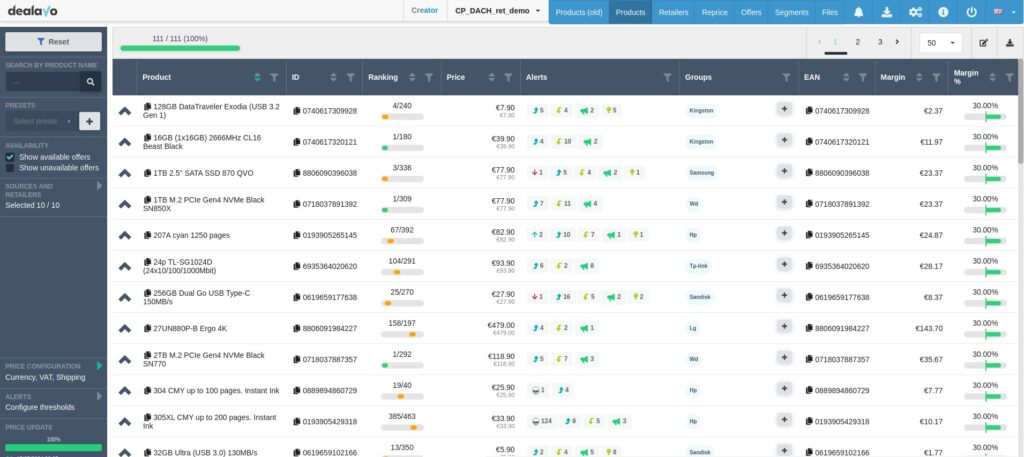
Key features:
– Price tracking: Get detailed data on competitors’ prices, promotions, and stock status.
– Dynamic pricing: Automate price adjustments based on market data.
Dealavo integrates with popular e-commerce platforms like Magento, WooCommerce, and Shopify, and offers custom API integrations. Data is meticulously mapped with advanced algorithms and verified manually, providing high accuracy. Clients benefit from a dedicated customer success manager and customisable integrations to meet specific business needs.
Pricing rules in Dealavo
See how pricing rules in Dealavo work based on the simple example below.
How to easily maximise your profit in an online store
Generating maximum profits is a top priority for every entrepreneur operating in the e-commerce industry. However, achieving this goal requires a precise pricing strategy that ensures market competitiveness and encourages customers to make purchases.
With our Dealavo platform, you can effectively monitor competitors’ prices and make strategic decisions based on real market data.
How does it work in practice?
Let’s say your product is priced in the middle range, yet it generates minimal traffic to your website due to its relatively high price. With the full automation available in the Dealavo tool, it’s possible to set precise rules. These rules will now act as guardians of your product’s price. They will adjust it to attract even more customers by reducing your margin by just 0.1%.
This slight change will put you in a leading position and increase traffic to your site significantly. In practice, this translates to an increase in real profit!
Prisync
Prisync offers price optimisation and inventory management for online retailers, monitoring competitor pricing and stock levels. By simply adding product URLs, users can track price changes and availability in real time. It also includes data import, real-time stock tracking, and pricing analytics.
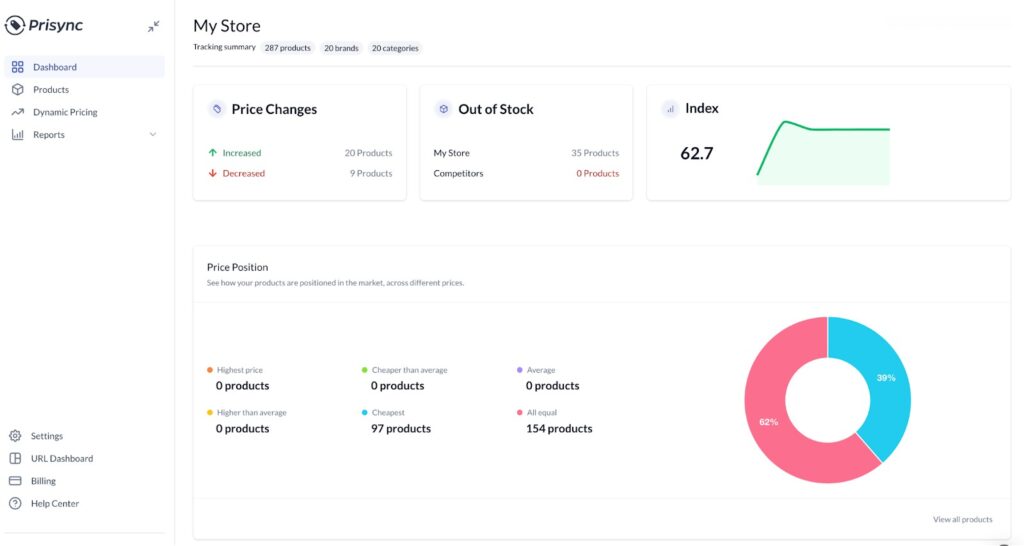
Available for a 14-day trial, Prisync uses undetectable bots to gather data discreetly. Despite some limitations, its effectiveness makes it a reliable tool. Subscription plans range from $99 to $399 per month.
Check how Dealavo is different from Prisync
Price2Spy
Price2Spy is a versatile price monitoring tool for manufacturers, brands, and distributors. It tracks competitor prices, provides reports, and analyses historical trends to aid in price strategy. Users receive immediate updates on price changes and can set alerts for daily or immediate notifications.
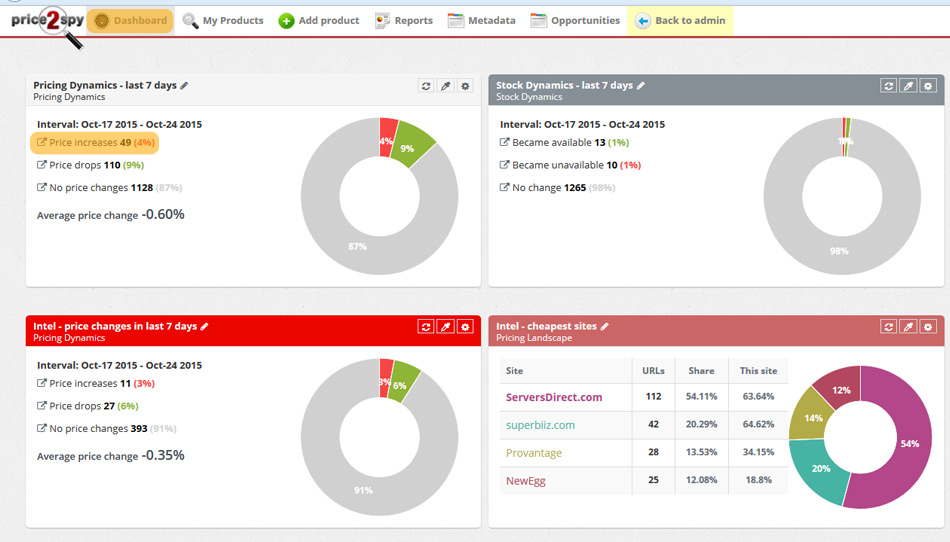
Price2Spy offers a 30-day free trial and integrates with platforms like Shopify, Magento, and BigCommerce. The pricing structure depends on the number of product URLs, starting at $26.95 per month.
Check Price2Spy alternatives
Competera Pricing Platform
Competera uses AI to analyse over 60 pricing factors, helping businesses make informed decisions. Its features include:
- Competitor data: Access near real-time competitor insights.
- Dynamic pricing: Automate pricing based on market conditions.
- Price optimisation: Use various strategies to adjust prices effectively.
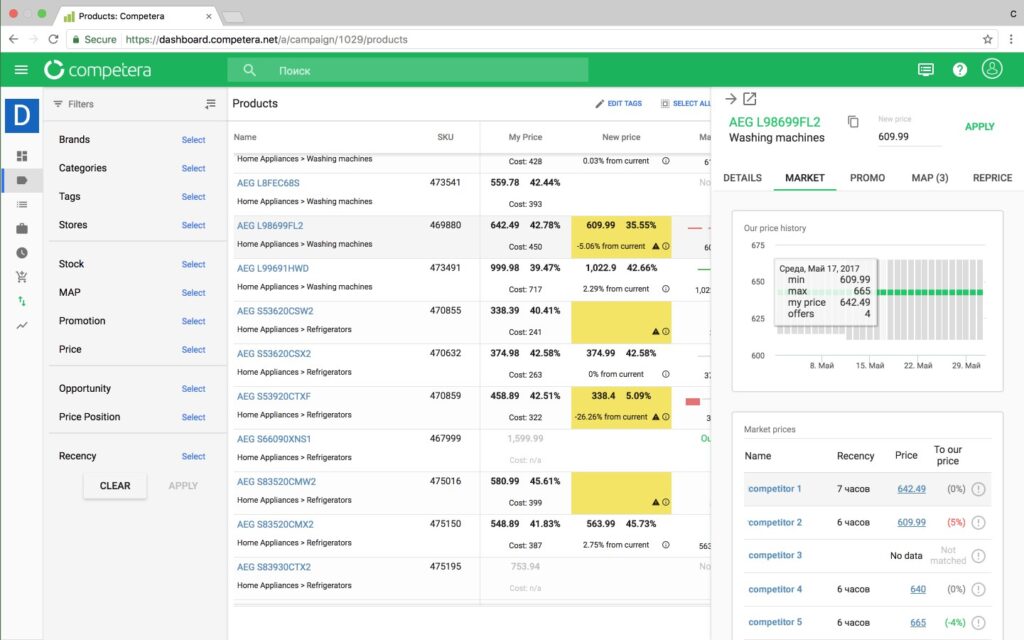
ompetera supports unlimited data comparison, making it scalable for any e-commerce business. Pricing plans are available upon request.
Check Competera alternatives
Wiser
Wiser Solutions is specialised in Commerce Execution SaaS. Who can benefit from its solutions? Naturally—retailers, brands, or distributors. All of this to make better and more efficient decisions regarding market awareness and price management. So far, over 500 brands have equipped themselves with Wiser Solutions, indicating better data as one of the most important benefits. Multichannel visibility will certainly help your business. Sadly, however, team members’ accounts need to receive a prior approval and can’t be set up automatically.
- Pricing plans are available only upon request.
- You can find one of the Wiser Solutions tutorials here.
- Check their profiles on LinkedIn, Twitter, and Facebook.
- Ratings and reviews can be found here.

Compare Prisync vs Wiser
Check Wiser alternatives
Intelligence Node
The tool has many distinctive divisions: pricing & promotions, assortment & availability, brand production solutions, and digital shelf analytics. Noteworthy is also IntelligenceNode’s accuracy, amounting to 99% when it comes to delivery of data intelligence. Importantly, numerous market leaders have decided to choose the platform: Prada, Lenovo, Nestle, or LIDL, accounting for over $600 billion in revenue internationally.
- Pricing includes an Enterprise Plan (free trial); a Lite Plan ($1,000 a month); and a PRO plan (free trial); an API Access ($1,000).
- There are no tutorials for IntelligenceNode available.
- Check their profiles on LinkedIn, Twitter, and Facebook.
- Ratings and reviews can be found here.

Skuudle
Skuudle, a UK-based platform, focuses on product intelligence and price optimisation, aiding businesses in adjusting prices based on market dynamics. It offers a customisable analytics dashboard, historical data insights, and tailored pricing plans based on client needs. Skuudle claims a product-matching accuracy of 99.9%.
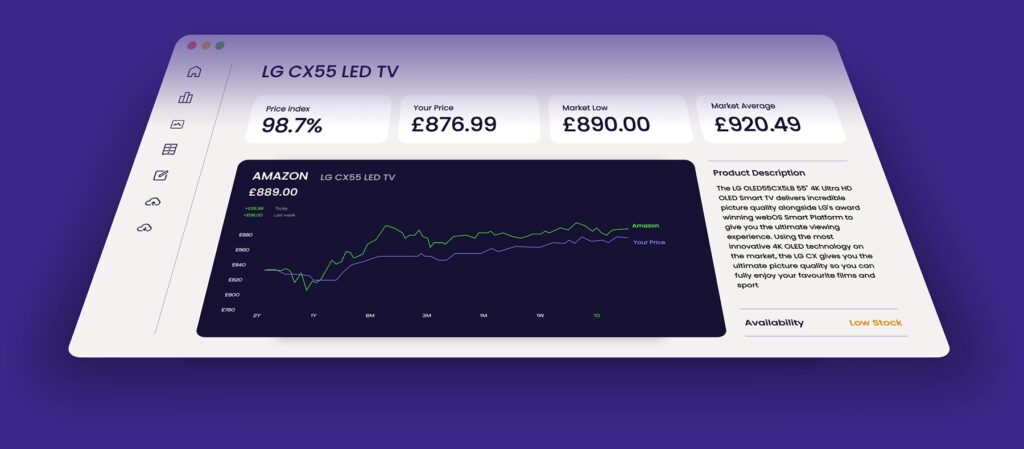
These tools are invaluable for any business seeking to stay competitive in a dynamic market, offering solutions for price monitoring, optimisation, and strategic pricing decisions.
Check Skuudle alternatives.
Key functionalities of a price tracking tool
What should you look for in price monitoring and repricing software?
- Clear market overview: A good tool should help you assess your market position and identify key competitors. For instance, Dealavo lets you view your position for each product and see how many other shops offer the same items, highlighting shared products with competitors.
- All data in one place: Consolidating data from multiple platforms into a single panel allows you to quickly understand the market dynamics at a glance.
- Data displayed in charts: Charts are the most effective way to visualise trends, showing competitor price changes over time.
- Dynamic pricing: To respond swiftly, dynamic pricing with customisable rules is essential. Professional tools should allow different pricing strategies based on channels or regions.
- Email alerts: Stay informed with email notifications on significant price changes or market opportunities. Tools like Dealavo allow you to set specific alert criteria, such as a price drop exceeding 15%.
- Tracking different variants: It’s crucial to track various product packages as separate SKUs, like different bottle sizes.
- API Integration: API integration is vital for incorporating tool data into your system, especially when tracking numerous products.
- Data in CSV format: Having data available in CSV format aids in detailed analysis.
- Availability information: Knowing product availability is crucial, as competitors may list items at low prices but have no stock. Tools should provide availability insights to help you spot opportunities.
- Frequency of updates: Frequent updates are critical for quick reactions. Monitoring at various times ensures you catch time-sensitive promotions, like “night sales.”
Below is a comparison of popular price monitoring software, highlighting key features, report options, and customer service capabilities. This table is based on information available on each company’s website.
Maximising your business with price monitoring software: integration capabilities explained
Price monitoring software is essential for businesses that want to stay competitive. These tools provide valuable insights into market trends, competitor pricing, and consumer behaviour, allowing companies to make data-driven decisions. However, the true power of price monitoring software, such as Dealavo, is unlocked when it is integrated with other essential business systems.
Integrating price monitoring software with other tools helps streamline operations, enhance decision-making, and improve overall business performance. In this article, we will explore the integration capabilities of price monitoring software and how Dealavo can be easily connected with other systems to provide a seamless flow of data.
The importance of integration with other systems
In a complex business environment, using multiple standalone systems can lead to data silos, inefficient workflows, and missed opportunities. Integration of price monitoring tools with other business systems allows for:
- Enhanced decision-making: Integrated data provides a holistic view, enabling better strategic decisions.
- Operational efficiency: Automation of data flow reduces manual work, saving time and reducing errors.
- Real-time insights: Integrated systems offer real-time updates, crucial for making timely adjustments in pricing strategies.
- Scalability: As businesses grow, integrated systems can easily accommodate increased data and workflow complexity.
Types of integrations available
Price monitoring tools like Dealavo can be integrated with various categories of software to maximise their impact. Here are some of the key types of integrations available:
ERP systems
Enterprise Resource Planning (ERP) systems are at the heart of many businesses, managing core functions such as inventory, accounting, and supply chain management. Integrating price monitoring software with ERP systems provides several benefits:
- Automated price updates: ERP systems can automatically update pricing information based on real-time market data from price monitoring tools.
- Inventory management: ERP systems can adjust stock levels and reordering policies based on competitor pricing and market trends.
- Financial reporting: Accurate and up-to-date pricing data enhances financial analysis and reporting.
CRM software
Customer Relationship Management (CRM) software helps businesses manage interactions with current and potential customers. Integration with price monitoring tools can enhance CRM functionalities by:
- Personalised offers: Leverage competitor pricing data to tailor offers and discounts for different customer segments.
- Customer insights: Understanding market trends helps CRM systems provide better insights into customer behaviour and preferences.
- Sales strategy optimisation: Real-time pricing information enables sales teams to adjust strategies and close deals more effectively.
E-commerce platforms
E-commerce platforms are crucial for online retailers who need to stay competitive in the digital marketplace. Integrating price monitoring tools with these platforms provides:
- Dynamic pricing: Automate pricing adjustments on your e-commerce site based on competitor activity and market demand.
- Stock level adjustments: Synchronise stock levels between the e-commerce platform and price monitoring tools to avoid overstocking or stockouts.
- Enhanced customer experience: Consistent and competitive pricing improves customer satisfaction and loyalty.
Read about: Things you can change instantly thanks to price monitoring
Check also: Using price monitoring to find unauthorized resellers
How Dealavo supports integration
Dealavo is a robust price monitoring software that offers a wide range of integration capabilities, making it easy for businesses to connect with other essential tools. Some of the important integrations include:
Read more: How can price monitoring software help you save big on your e-commerce purchases?
Here’s how Dealavo supports integration:
API availability
Dealavo provides powerful APIs that allow seamless integration with other systems. APIs enable the smooth exchange of data between Dealavo and your existing software ecosystem, allowing you to pull real-time pricing information directly into your ERP, CRM, or e-commerce platforms. This flexibility ensures that businesses can customise integrations according to their specific needs.
Seamless data flow and synchronisation
Integration is not just about connecting systems—it’s about ensuring that data flows seamlessly between them. Dealavo’s integration capabilities ensure synchronised data across all connected platforms, providing a unified and accurate view of market conditions. This seamless data flow eliminates manual input errors, reduces processing times, and provides up-to-date information at all times.
- Real-time data sync: Keep your systems updated with the latest market data to make timely decisions.
- Automated workflows: Set up automated rules and triggers that respond instantly to market changes, such as automatic price adjustments.
- Custom integration options: Dealavo can be customised to meet the specific integration needs of your business, whether through pre-built connectors or tailored API configurations.
Integrating price monitoring software like Dealavo with other business systems can revolutionise the way you operate, providing enhanced visibility, improved efficiency, and better decision-making. Whether you are integrating with ERP systems, CRM software, or e-commerce platforms, Dealavo’s robust integration capabilities ensure that your data is always synchronised, accurate, and actionable. By leveraging these integrations, businesses can stay ahead of the competition, optimise their pricing strategies, and drive growth in a dynamic market landscape.
Investing in a price monitoring tool that supports broad integration capabilities is not just a tactical move – it’s a strategic necessity for businesses that aim to thrive in today’s competitive market.
Conclusion
Price monitoring is a critical factor that drives the growth of any e-commerce business and allows companies to stay competitive in the dynamic landscape of online trade.
Price monitoring tools should be taken for omnichannel and offer a variety of functionalities. It is imperative to choose the software that ensures up-to-date information, useful filters, notifications and historical data, so you can develop your future pricing strategies more accurately.
Dealavo provides a complete suite for price monitoring and repricing, with a number of very useful functionalities. Contact us and request a free demo. Check out our solution yourself!

